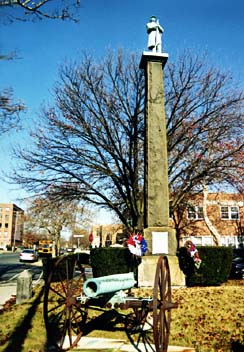|
28. Asbury Park From Kingsley Street to Main Street Grand Avenue, Part 2 The First M.E. Church (Methodist Episcopal) is diagonally across the street from the library. It was built in 1919 and displays Romanesque and Byzantine influences. Most of the present-day Grand Avenue churches (pictured on this page) are second-generation buildings. The Church shown below was built to replace an earlier structure, which was destroyed in Asbury Park's worst fire, on Good Friday, 1917 (ever since that time known as "Lousy Friday, 1917.")
Image
1.27.2: The First Methodist Church. Unlike in this early photo, One of Asbury Park's greatest losses was the destruction by fire of the First Presbyterian Church, in 1979. Built in 1893, it was on the southwest corner of Second and Grand. Right after the destruction of the First ME Church in the 1917 fire, the First Presbyterian admitted the displaced congregation to worship there until a new church could be built. Sixty-two years later, the First ME Church returned the favor by opening its doors to the congregation of the First Presbyterian.
Image 2.27.2. The First Presbyterian Church. A beautiful feature of the First Presbyterian was the rare green stone that fashioned its exterior. The stone was mined near Embryville in Chester County PA; its color was formed by the dripping of water through copper deposits. The seating of the church was in a circular fashion around the pulpit. The new First Presbyterian is in the town of Wayside, a couple of miles away. A dusty lot, with a few trailers, currently marks the spot where the Grand Avenue church stood. Resting on the southwest corner of Grand and Third is the First Baptist Church. It was completed in 1906. Its breathtaking Romanesque design carries, for me, much "soul-appeal." It seizes the imagination, takes you "Elsewhere." I really love standing on the corner in front of it.
Image 3.27.2. The First Baptist Church. Many more churches grace the city of Asbury Park. (Click HERE to see two more Grand Avenue examples.) Asbury Park was a town fairly steeped in religion. Of course, was named after Francis Asbury (1745 -1816), the first Methodist Episcopal Bishop ordained in the United States. He was born near Birmingham, England and came to America at age 26, already ten years into his religious calling. John Wesley, founder of the Methodist Church (and who Wesley Lake is named after) appointed Asbury bishop in 1784. A remarkably prolific sermonizer, Asbury preached four times a week for most of his life, traveling everywhere on foot. It is said that he crossed the Allegheny mountains sixty times. Under his leadership the ranks of Methodism grew by over 200,000. Jumping back south to Grand and Cookman Avenues, we find a monument erected "In memory of those who fought in defense of the Union." It is, of course, the Civil War Monument or the "War of Rebellion" monument, as its plaque indicates.
Image
4.27.2. The Civil War Monument. Grand Avenue is at left. We are now on Cookman Avenue facing north (just two blocks west of the Saint James Theater and one short block up from Wesley Lake, which we can see down the street if we turn around). Let's stay there for a while. Cookman was a great all-American shopping street. Let's turn left and walk two short blocks west to the heart of Cookman...
[Tour Index Page] [Asbury Index Page] [Main Page]
|



